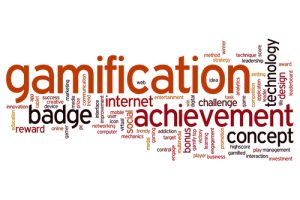 Gamification is becoming the norm in today’s e-learning. Eighty percent of learners say they feel they’d be more productive if their work or study was more game-like. And that’s not just work-shy slackers talking: 61% of senior executives say they take daily game breaks at work, with many saying it makes them feel more productive.
Gamification is becoming the norm in today’s e-learning. Eighty percent of learners say they feel they’d be more productive if their work or study was more game-like. And that’s not just work-shy slackers talking: 61% of senior executives say they take daily game breaks at work, with many saying it makes them feel more productive.
Of course, there’s a difference between playing games and gamification. Gamification isn’t just about having fun at work. It’s about designing your e-learning from the ground up to integrate the proven principles and mechanics behind successful games. The result? Engaged, motivated learners – and fun at work.
Some experts say the airlines invented gamification with their frequent flyer programs. Their use of points, status, and rewards have made these programs wildly popular for years, so that now just about every consumer business has some sort of loyalty program. Companies have trained their customers in the desired behavior – coming back again and again – because customers like racking up points, reaching new status levels, and cashing in rewards.
The same can happen in e-learning. Designing good gamified learning can get people hooked and make sure your learning is effective. Depending on your business goals, you can design gamified employee onboarding that rewards collaboration, competition, altruism, creativity, or whatever behavior you want to encourage.
But gamification can also be tricky. It’s easy to get carried away with creating a flashy interface and fun interactions. That’s why it’s so important to focus on business goals, then use game techniques as a way of guiding learners toward those goals.
How does that work? Just think about how these five common elements of gamification can be used to shape learning.
5 gamifying elements
1. Timed challenges: Most TV game shows incorporate some sort of timed challenge. Along with tension-building music, this adds excitement and rewards players who can keep cool under pressure. For jobs where speed, accuracy, and on-the-spot decision making are required, timed challenges can help learners practice these skills in a safe and fun environment.
2. Points: Points can be a great motivator. You can design a gamified training course where learners compete against each other to see who can get the most points, or compete against their own previous scores. Learners can earn points individually or as part of a team, depending on the behavior you want to encourage. You can even give out real-world rewards tied to points.
3. Leaderboards: Reward excellence and encourage friendly competition by posting leaderboards. This can give people an incentive to take their training more seriously. There are many ways to incorporate leaderboards into gamified training. The most important thing to remember is that leaderboards should motivate, not discourage, learners.
4. Badges: Badges can create a sense of belonging and recognition – if designed and used thoughtfully. Create badges that are attractive and collectible, then tie them to events and progress in your training so that they have meaning to learners. Like points, you can tie badges to real-world rewards.
5. Levels: Levels show progress through a course and help learners feel a sense of accomplishment. Consider awarding levels tied to real-world skills; when learners master a specific skill, they move up a level.
Summary
Build gamification into your e-learning from the ground up; that way it won’t be a distraction, but an integral part of the learning process. Use proven gamification strategies to build and reward the business goals and behaviors you want to encourage. A bonus: increased morale, higher engagement, and more fun in the workplace.